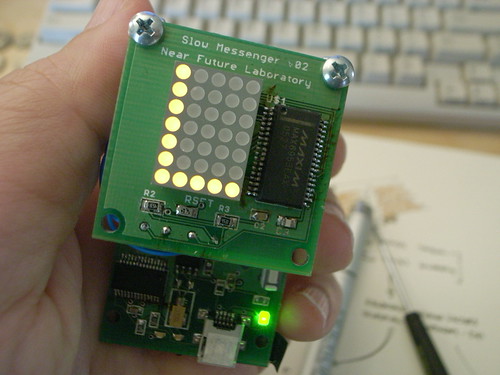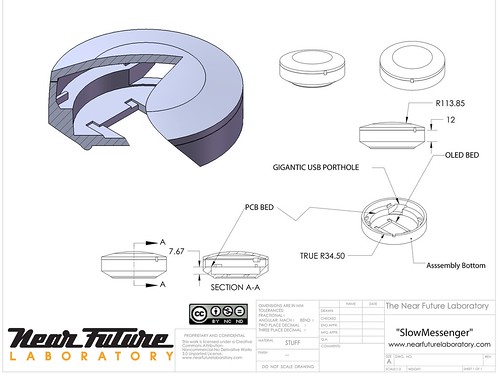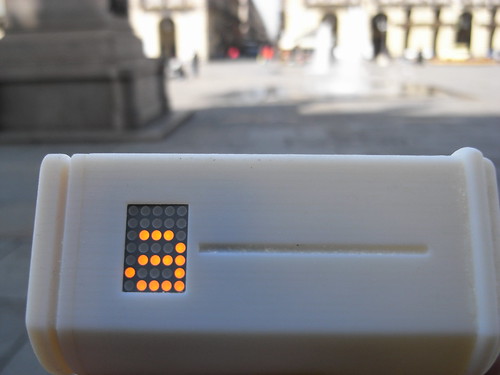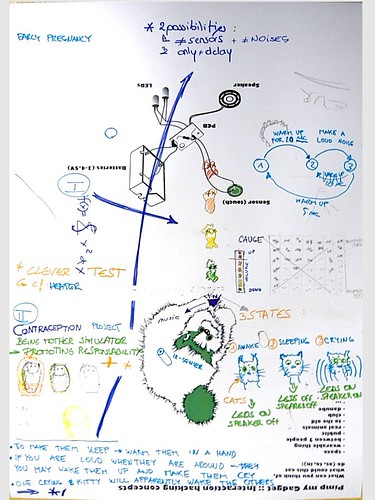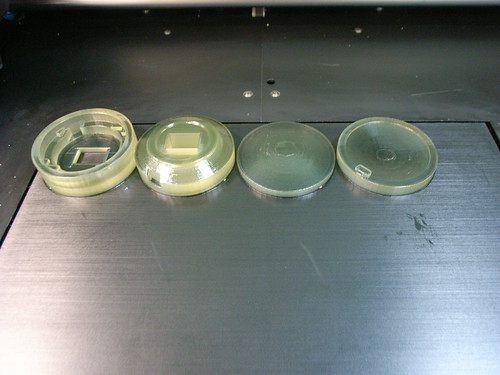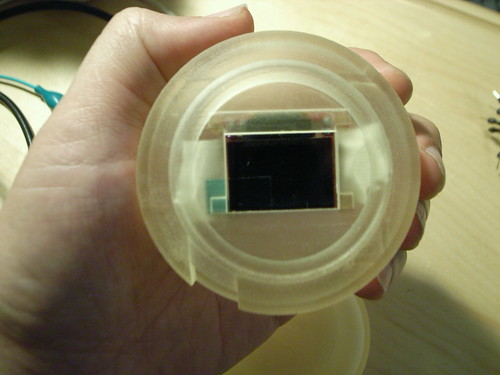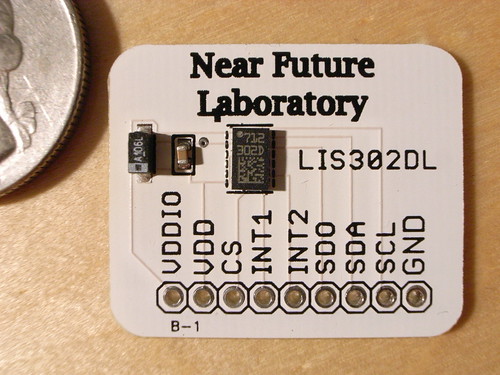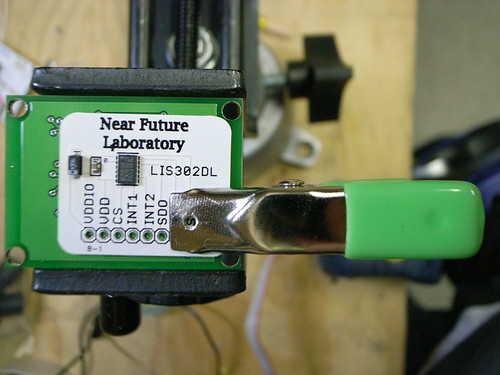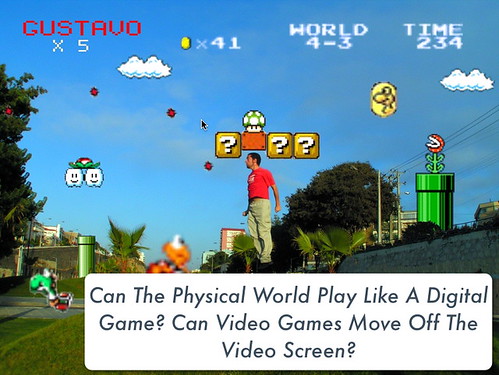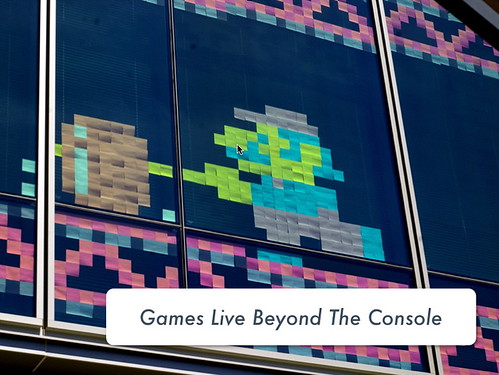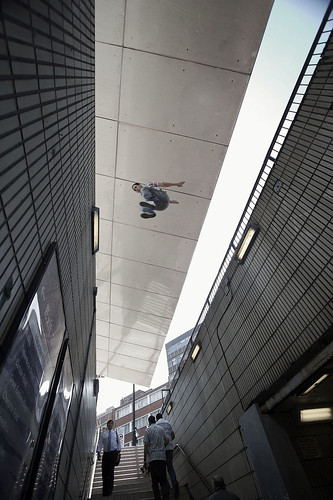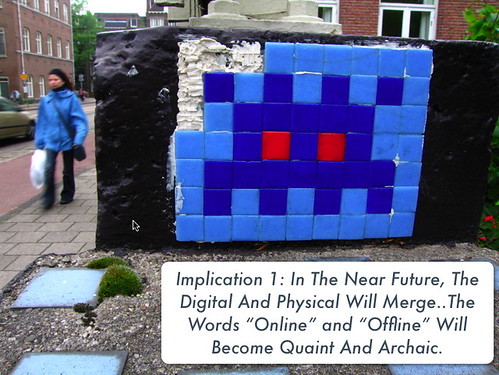Giulia Simi interviewed The Near Future Laboratory over at Digicult Magazine. It’s all in Italian, but I’ve provided the original that was translated for the article.
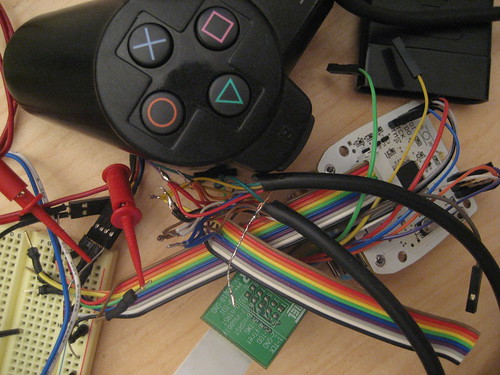
Question: Starting from project name: “Near Future Laboratory”. I immediately notice the importance of time and a sort of redefinition of the concept of Future that probably has been changed by technologies. Also I read “laboratory” like something having to do with a research/experimental approach. So we can say you are a group of people who try to explore the possibilities of our future through technology and digital media, without a market mediation‚ and this is in my opinion what you link you with art.
How did your project begin?
The project began because we thought there was an empty space between consultancies that were hired to build things and consultancies that were hired to think about what things should be built based on trend analysis and other such predictive practices.
We see an opportunity in a design and research practice that operates between traditional long-term academic research studies and short-term commercial product development. In between – 12 months to 4 years – is a gap we call “the near future.” We think there are often unreasonable constraints within the design innovation and R&D practices of existing commercial enterprises to build for the market such as time. You get this constraint from the front office to come up with something, as part of R&D or design innovation, that can be channeled quickly to product development so as to have the return on investment line on next year’s financial books net out in a way that will make investors happy. Academic R&D is just run through with challenges that make it difficult to create “outside-the-box” innovations. First is a horribly broken peer-review system, institutional politics that still operate as if it were the 19th century, a glacial and costly system of publishing and knowledge circulation practices, and little value placed on undisciplinary scholarship. It’s just abysmal.
What we’re trying to do is encourage design innovation that does away with constraints like these. We have no expectations or requirements that we will make something that millions of people will want, although who knows? The point is that we don’t make these kinds of assumptions; we operate quickly and economically; we do not censor our projects based on factors like the expected market of consumers; we are committed to circulating knowledge and insights quickly – within months, not years – using creative commons and not the feudal pay-for-knowledge professional society journals and conferences, and so forth.
This is how the project began. As a positive reaction to the difficulties of engaging in creative, insightful, fun and innovative work with fewer of the constraints we have found in academia and in the normal commercial world.
We needed some way to describe the space of possibility for the work we were interested in engaging. Using time as the catch-all “idiom” in which we worked seemed right. It’s not just time in that we do projects that relate to time – but that we are very deliberately thinking about what might be, in some perhaps fictional near future world. In a sense, we are “authoring” some little corner of the near future in much the same way that Bruce Sterling will write about a near future fictional world. Only, we’re not fiction writers – we’re fiction makers. Fiction makers constructing artifacts of a near future world to help tell a story about the world we live in now.
We use this notion of a near future time, rather than, say “mobile technology” or “digital games” as the catch-all for the kind of work we doThe near future is a blurry space that is almost, but not quite, but close enough to seem possible.
On one hand, the near future is an upcoming moment of time that ranges from the next second to 3-4 years ahead. Thinking about it is some sort of short term foresight: looking at or creating an almost immediate period of time. Some people may call it “design” because it’s about creating the next “big things” or “disruptions” but this is not the point here. The idea is rather to generate interesting stuff with the tools and tech we have today, some sort of bricolage. For instance, instead of being all hopped up on 3D renderings or Second Life advertisements, our preference is to explore “low bandwidth” creativity such as Habbo Hotel.
On the other hand, the “near future” refers to what is ignored or left aside by what I call the “future stakeholders”: mostly corporate R&D/innovation labs; serious designers; policy makers. The near future is not an alternative world, it’s just there but observable from a different angle. Envisioning it is a matter of examining the edges and fringes so as to articulate ideas, concepts and knots that do not resonate with conventional, inside-the-box business practices – we look for topics or social practice idioms that have been left behind or forgotten or lurk just below the surface. This might sound very William Gibson-esque (“the future is already here, it’s just not evenly distributed”) but yes we do think the future is hidden in dusty corners: the point is to explore forgotten realms or look at things from a different or even orthogonal angle. There is a quote we really like, which echoes that feeling: when confronted for the first time to Niagara Falls, Oscar Wilde said “It would be more impressive if it ran the other way”. This is a good motto for the Near Future Laboratory about how to do our research. Yes, we are observing the social and cultural areas of our technological world, but upside down.
In a sense the near future world is also a place we’d like to inhabit, a mixture of today’s seriousness and fantasy, utilitarian and non-utilitarian situations. It’s made out of cardboard, dirt, duct tape, tubes, bad wiring and vinegar waiting to be turned into a playful and sustainable environment. What is important here is not the Utopian vision but rather the idea that the near future can be more habitable, more playful and just different from the routine, tired old activities today – simply if we want. And that is the laboratory aspect – we can make new things — actually construct them in an experimental process that couples culture-making with engineering and design and manufacturing — because they seem intriguing or thought-provoking. This to me is what a proper laboratory does — it makes culture. We’re a kind of culture-making laboratory in our own modest way, through the practices we know well — engineering, design, anthropology, and our own peculiar way of seeing the world.
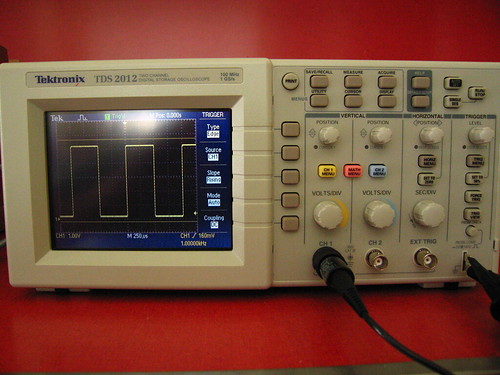
Question: In your project description you speak about “weak signals” of our digital culture that you focus and “expand” to create prototypes of near-future products. I really like this definition. Could you tell us some examples of what you define “weak signals”?
The “weak signals” concept emerge from the literature about foresight, long-range design and futures research. It evokes the notion of early instances about phenomena that may become important in the future. To some extent, it’s behavior, attitudes, products or services of today that announce the future. As William Gibson put is “the future is already there, it’s just not evenly distributed” which means that weak signals are here and can be found. The second step is to ask oneself critically if these signals are important and relevant to an almost-future that is arriving: if yes what might they announce? and should they be amplified? Doing future research is not just about spotting trends, it’s also about creating one’s own futures by amplifying certain signals. That is, taking into account not just what one “sees” happening in these weak signals, but also what one imagines could also happen or might be exciting to experience, and so forth. I think this is the point at which many intriguing ideas turn into “projects” that require commitments of time, money, programming, and so forth. Many of these ideas come from a desire to experience some idea that, perhaps, is based on intuition, or a passage in a book (science-fiction or not) or a joke or a bit of irony one finds cropping up again and again in one’s real-world experiences. You ask yourself – perhaps this little bit of social action I see out there, or experience in my life – perhaps this tells a compelling story that other people may be interested in experiencing themselves?
Just to keep our work organized – there are actually way too many prototypes in progress now, which may actually be a good thing in terms of diversifying what we think about – we divide our projects into themes. One theme into which many things fall is “new interaction rituals.” Here we are interested in how the ways we represent ourselves in computer-mediated environments can be shaped or modified in some way through action that happens without the usual computer setup of sitting in front of a screen, with a keyboard and a mouse. Where are the other “interfaces” to our digital lives? Can my representation online, on the internet, in video games, as our Facebook representations, etc. be shaped by things other than button presses while sitting down for hours in front of a video game console or while browsing the dozens of social software sites on which I have all these different expressions of myself, my personal life and so on?
We’re going about his in a very simple way. A few of the devices we’re building record physical movement in a variety of ways. One project turns you into a kind of “human joystick” so that your very broad movements, such as running the length of a football pitch – much broader than moving a computer mouse or pushing a button – are required to play a video game you see on a small hand-held device. Another project goes even further – the physical movement you might endure while going for a 4 mile hike becomes a “move” in a different kind of video game. The same physical activity might be what is necessary to “charge up” a very peculiar new video game controller so that it has the “power” to allow you to play a video game. Then we have a variety of interface experiments to enroll “new partners” into interactions – these are projects that allow us to use digital networks and devices to communicate with weather and pets. We’re very interested in this area of possibility – not just what new “things” we can interact with, but also what the new paradigms for sharing experiences might be. Pets are particularly relevant, as are other critters and the weather.
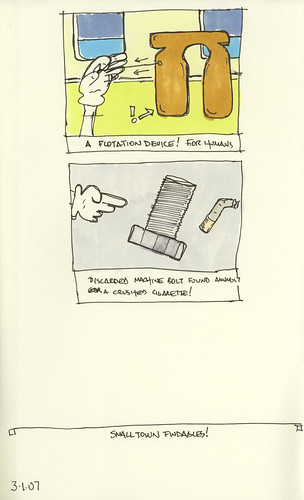
Question: In a long and interesting post related to “Slow Messenger” project you speak about “making our own stuff” – hardware sketching – like a cultural and political message. That’s something related with DIY sensibility and the will to control the creative process, that software artist also make in evidence. So can I define your projects a sort of hardware art?
We’ve talked about it as “device art” which seems closer to social practice than hardware in our way of thinking. “Device” somehow connotes purpose or suggests a particular stratagem to achieve a goal. There is also this idiom “left to your own devices” which basically means what you would do without constraints or on your own, with what you have around you. Device also has a kind of “special purpose” meaning to it – something that has a specific action to perform, also a way to get something done, as in a plan to achieve a specific goal. It’s a richer way of describing these little assemblages we’ve been creating that are active in unexpected ways.
There’s also a political impulse that we’re investigating. On the one hand we’re interested in the kind of expressive power these devices have in their ability to shape how one experiences certain simple aspects of the world. For example, with Slow Messenger – how can we shape one’s relationship to one specific friend or loved one by unlocking a special message from them simply by holding a messaging device for a long period of time? That’s a very simple, plain, somewhat orthogonal experiment that changes the way people communicate in today’s digitally networked age. It’s orthogonal in that it does something quite unexpected given conventional assumptions about technologies as communications utilities. On the other hand, the process of taking that thought – a peculiar idea that popped into my head during a long-haul flight from Berlin to Los Angeles – and expressing it as an assembly of “some thing” is quite instructive. What we find engaging is actually experiencing the process of expressing the design through its multiple stages of evolution and tying all these disparate bits together. We’ve learned that technologies are social practice – meaning that they are more than just a static, inert component. They are embodiments of a variety of social forces and when we make our own stuff, we can see all those factors and influences in play and then never really look at technologies the same way again. Wrapping all the aspects of the Slow Messenger project is instructive in this way. It ties together this vague day dream on an airplane flight, some sketches in a notebook, probes of relevant prior art, some books on the social character of time, the history of the telegraph, interesting reports on submarine communication (which is very, very slow because of the physics of radio transmission through salt water) and the political issues associated with military command and control networks and of course all of the application notes and specifications and design requirements of the individual electronic components used in constructing the actual Slow Messenger device.
This is an absolutely crucial aspect of the process for us. It’s not enough any more to have ideas that cannot be experienced “in the hand” or lived with in some fashion. This isn’t to say we privilege material over ideas, but what we mean is that the action involved in materializing ideas draws one into an incredibly rich world that turns back around to inform the ideas you have. There’s also validation and satisfaction that comes with crossing back and forth between ideas and their expression and articulation into something that you can point to and say – “this takes an idea I had and allows you to experience it, first hand.” The digital culture we live in nowadays, and within which The Near Future Laboratory finds itself circulating puts great emphasis on being clever both with one’s ideas and in their expression – it’s good to have expert Ninja skills for both thinker and tinkerer at the same time. It helps justify the new kind of practice we’re trying to develop.
Thinking as making – or thinking while making is a way to invigorate and make richer the analytic work that goes alongside of the construction of artifacts in the laboratory. We have a sense that there is a stronger basis for analysis, a more informed basis upon which to synthesize material into actionable reports, and an infinitely better appreciation for the meaning of these new social practices. There’s a certain validation and authority that comes from not just analyzing from afar, but from engaging the practice deeply.

Question: “Slow Messenger” is in my opinion the most interesting project you developed up to now. There’s an overturning of usual perspective, according to which technology has to create devices reducing time of communication independently from physical ties. On the contrary, you created a device that, not only slows down the communication process, but links it with our physical movements. Do you think that could be a realistic possibility technology stop searching time acceleration? Or probably the slowing down will be always and only an excentric and artistic gaze on reality?
It’s not unrealistic, certainly, if only measured by your response. I can imagine that there would be some people for whom this kind of interaction would be desirable in particular contexts. There’s an intimacy to this kind of message sending and receiving paradigm that was what motivated the project. There are messages one may want to languish over – or messages from individuals that we would want to savor and take time receiving. We were trying to capture the deliberate, “writerly” character of pre-digital communication, like letter writing. With pen and ink.
Efficient, quick communication is a product of power-politics. In order to exert one’s influence geographically, it’s necessary to communicate one’s will over distances and do so in as little time and with as much efficiency as possible. Slow messaging just doesn’t make sense in that context. And that simple necessity has soaked through most of our forms of communicating, even when we are not particularly powerful. It just becomes an assumption that communication happens quickly – not because it cannot be any other way, but because it has become part of the unquestioned “DNA” of communication as a social practice.
But, as in most of our projects, we want to work from unconventional assumptions in order to see what the experiences of communication in a different “anti-” universe might be like. What can we learn about our existing social practices of communication – instant messaging, SMS, always-available styles of presence online – if we do an experiment where the assumption is the opposite. In this case, if we make communication much slower, what do we learn about new ways of relating and sharing with our friends and loved ones? We’re not necessarily assuming that this is the best way to communicate, for example. We’re not making a new product or something of this sort. It is very much an experiment in design as a way to answer some perplexing questions about the relationships we maintain through all these peculiar and compelling messaging systems.
Thank You.
You’re very welcome!

